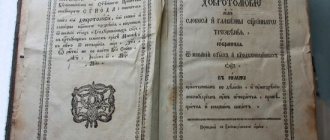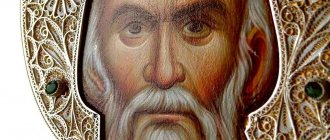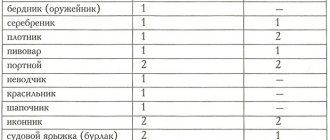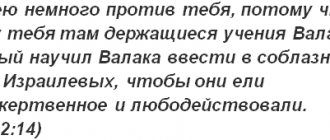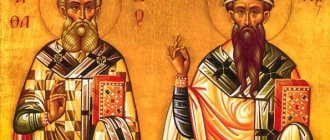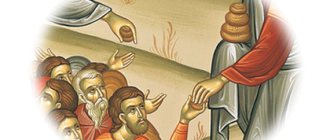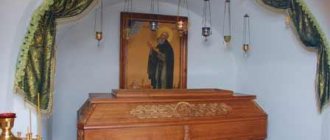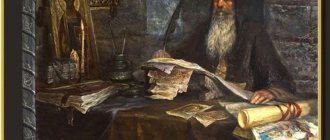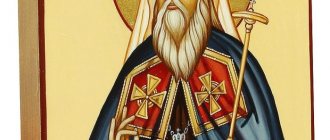IGNATIUS
Genus. in a noble family, he was the eldest of 9 children of Alexander Semenovich (1784-1875) and Sofia Afanasyevna (1786-1832) Bryanchaninovs; The Bryanchaninov family goes back to the associate leader. book Dimitry Ioannovich Donskoy to Mikhail Brenko. I.'s father, once close to the court, was a poor landowner at the time of his son's birth, however, despite limited funds, on his family estate, s. Pokrovsky maintained a parish school, in which approx. 50 peasant children. Among his brothers and sisters, I. stood out for his abilities (in addition to general education subjects, he learned Latin and ancient Greek, drew well, sang, and played the violin) and seriousness, as well as deep and sincere piety. He often attended church and prayed for long periods at home. His favorite reading at that time was “The School of Piety” (5 volumes), containing a description of the deeds of the saints and their sayings. The basics of theology were taught to him by a student from the Vologda DS. Already in his youth, I. realized the difference between his aspirations and the environment in which he lived: “My childhood was filled with sorrows... I had no one to open my heart to: I began to pour it out before my God, began to read the Gospel and the lives of the saints...” (My cry // Complete collection of works. T. 1. P. 514-515). His father prepared him for a military and court career, and he himself wanted to become a monk.
St. Ignatius (Brianchaninov). Photo. 1865 St. Ignatius (Brianchaninov). Photo. 1865
In 1822 I. entered the Main Engineering School. Thanks to his academic success, he soon became known to the Inspector General of the Engineering Troops. book Nikolai Pavlovich (see: Nikolai I Pavlovich, imp.), who was in charge of the school, and was appointed as a boarder. Kng. Alexandra Feodorovna. Throughout his studies, I. remained the first student and enjoyed the favor of Emperor Alexander I Pavlovich. 13 Dec In 1824 he was promoted to the rank of ensign engineer. At the same time, I. became close with the monks of the Valaam metochion in St. Petersburg and with St. Petersburg, who was there. Lev (Leonid) (Nagolkin), as well as with the monks of the Alexander Nevsky Lavra and the Lavra confessor, priest. Afanasy. Meeting misunderstanding among his peers, I. was forced to hide his way of thinking. One of the few trusted persons was Mikhail Vasilyevich Chikhachev (1806-1873), who remained his friend and spiritual companion until the last days of his life (he was tonsured a monk in 1860, accepted the schema in 1866).
Thanks to family ties with the president of the Academy of Arts and the director of the Public Library, A. N. Olenin, I. entered the circle of the capital's noble intelligentsia and writers. In Olenin's salon he met N. I. Gnedich, N. I. Grech, I. A. Krylov, K. N. Batyushkov, A. S. Pushkin, V. A. Zhukovsky, M. I. Glinka, as well as with the Muravyov brothers (who would become prominent military and government figures). At this time, I. wrote poetry, which, however, has not survived. I.'s spiritual formation occurred during a period of unrest in church life caused by the activities of the Russian Bible Society and the first translations of the Holy Scriptures. Scriptures in Russian language, the spread of mystical sects, the activity of the Orthodox Church. conservative guardians. I. sought to comprehend the various phenomena of the Alexander era. He wrote: “I was looking for certainty in religion. Unaccountable religious feelings did not satisfy me; I wanted to see what was true, clear, the Truth. At that time, various religious ideas occupied and worried the northern capital, bickering and fighting among themselves. Neither side pleased my heart; it didn’t trust them, it was afraid of them” (My Lament // Complete collection of works. T. 1. P. 515). The father, who dreamed of his son’s career, and the school authorities were wary of religions. I.’s aspirations and prevented him from frequently attending services and communicating with monks. At the request of the relatives of Metropolitan. St. Petersburg and Novgorod Seraphim (Glagolevsky) reprimanded the priest. Afanasy and forbade him to accept the young cadets Brianchaninov and Chikhachev for confession, but after a conversation with I. he lifted his ban.
St. Ignatius (Brianchaninov). Portrait. Ser. XIX century (GRM)
St. Ignatius (Brianchaninov). Portrait. Ser. XIX century (GRM)
In 1826, I. graduated from engineering school and submitted his resignation, which was rejected by the emperor. Nicholas I. In the spring of 1826, I. fell ill with a severe form of tuberculosis. The doctors sent by the emperor assured him that a monastic lifestyle was impossible for him. Contrary to the doctors' predictions, I. recovered. In Jan. 1827 ve. book Mikhail Pavlovich informed I. that the emperor was offering him, instead of resignation, a transfer to any guards regiment in the southern provinces of Russia that were favorable for health. “It is much more honorable to save your soul while remaining in the world,” said the Grand Duke. “To remain in the world and wish to be saved is, Your Highness, the same as standing in a fire and wishing not to burn,” answered the young officer (Biography of Bishop Ignatius Brianchaninov // Ibid. p. 25). After refusing the highest favor, he was sent to the engineering team of the Dinaburg fortress, construction of which began in 1810 on the bank of the West. Dvina. 6 Nov 1827, contrary to the will of his parents, I. retired for health reasons, having at the same time the intention of entering the monastery. “The heart has grown cold towards the world, towards its services, towards its greatness, towards its sweetness! I decided to leave the world, to devote my earthly life to the knowledge of Christ, to assimilate Christ” (Ibid. p. 522). Rev. had a great influence on I. in making the final decision. Lev (Nagolkin), with whom he maintained correspondence.
I. entered the monastery of Aleksandrov Svirsky in honor of the Holy Trinity (Olonets province) as a novice and was under the spiritual guidance of St. Leo. The parents refused to provide financial assistance to their son and stopped corresponding with him. In the monastery, I. performed various jobs: in a bakery, fishing, as a driver - showing complete obedience to the will of the elder. With the blessing of the elder, I. composed his 1st spiritual opus. "The Life of Schemamonk Theodore", a student of St. Paisius (Velichkovsky) and the teacher St. Leo. At the same time, he wrote prose miniatures “A tree in winter before the windows of a cell” (1828), “Garden during winter” (1829).
In 1828, following Elder Lev, I. moved to Ploshchanskaya Pust. Oryol province, and then - to Optina Hermitage, Kaluga province. Moving and poor nutrition weakened I.’s health, so in the end. In 1829, he stayed for a short time on the estate of his parents, who tried in vain to convince him to abandon the monastic path. Thanks to the patronage of Bishop. Vologda and Ustyug Stefan (Romanovsky) in 1830 I. settled in Semigorodnaya (Sedmigorskaya) in honor of the Dormition of the Most Holy. The Virgin Mary is empty, where he wrote “The Lament of a Monk.” In Feb. 1831 was moved to Glushitsky Sosnowiecki in the name of St. John the Baptist monastery.
June 28, 1831 bishop. Stefan I. was tonsured a monk in the Vologda Cathedral with the name Ignatius in honor of the saint. Ignatius the God-Bearer, was ordained a deacon on July 5, a priest on July 20 and left to serve at the bishop’s house. 6 Jan In 1832, he was appointed builder of the Grigoriev Pelshemsky Lopotov Monastery, Vologda province, which was in extreme desolation. I. improved the monastery; the number of brethren increased to 30 people. 28 Jan In 1833, for his work on the revival of the monastery, I. was elevated to the rank of abbot; At the same time, the parents reconciled with their son’s lifestyle.
The unfavorable climate (the monastery was located near the Pelshma River and was surrounded by swamps) and tireless work led to a deterioration in the health of I. M. V. Chikhachev, at the request of I., began to look for the possibility of moving to another monastery for him. Attempts to find a place in the Pskov or St. Petersburg diocese through the mediation of gr. A.A. Orlova-Chesmenskaya were unsuccessful, and only an appeal to St. Filaret (Drozdov) brought the desired result. In the summer of 1833, Metropolitan. Moscow offered him the position of rector of Ugreshsky in the name of St. Nicholas the Wonderworker monastery, noting: “The life and qualities of Abbot Ignatius are not unknown to me” (Biography... // Complete collection of works. T. 1. P. 38). However, the decision of the Holy Synod on the transfer was canceled by the emperor. Nicholas I, who remembered I. and wished to meet him. “I like you as before!” the emperor said to the young abbot at the audience. “You are in my debt for the education I gave you and for my love for you. You did not want to serve me where I intended to place you, you chose the path of your own free will, and on it you will pay me your debt. I give you the Sergius Hermitage, I want you to live in it and make a monastery out of it, which in the eyes of the capital would be a model of monasteries” (Ibid. p. 40). By personal order of the emperor, con. Dec. 1833 I. was appointed rector of the St. Petersburg Trinity-Sergius husband. deserts of St. Petersburg province. and 1 Jan. 1834 elevated to the rank of archimandrite. I. remained in the position of rector of the desert until 1857. The first concern of the abbot was the establishment of a strict order of worship, as well as internal discipline of the life of the brethren in accordance with the rules of monastic life. I. introduced the practice of revealing thoughts and delved into the spiritual life of every monk. Under his leadership, the monastery was revived: 3 temples and several were built. cell buildings, the rights of the monastery to own land were restored, and the monastic economy was organized. Financial support for the desert was provided by the imp. family, which favored I. In the summer of 1836, the monastery was elevated to the category of first-class, following. whereby the number of brethren increased from 13 to 42 people. I. also attracted monks from other Mont-Ray to the monastery. His assistants during this period were M.V. Chikhachev, priest. Feofan (Komarovsky; governor of the Sergius Monastery in 1836-1841), who arrived in the desert in 1835 from Kirillov Novoyezersk in honor of the Resurrection of Christ Monastery, Hierom. Ignatius (Vasiliev, nicknamed Ignatius the Great; deputy of Sergius in 1844-1851), who came to the desert in 1834 from the Spaso-Preobrazhensky Valaam Monastery, cell attendant I. Malyshev, later. archim. Ignatius (vicar of Sergius from 1857).
St. Ignatius (Brianchaninov). Portrait. Ser. - 3rd quarter XX century (?) (CAK MDA)
St. Ignatius (Brianchaninov). Portrait. Ser. - 3rd quarter XX century (?) (CAK MDA)
Since June 1838, I. was appointed dean of the mon-ray of the St. Petersburg diocese. In this service, he gained the trust and respect of both the abbots of Mont-Reuil and the monastic brethren, who saw in him not only a church administrator, but also an experienced mentor. In con. 30s I. supported St. Lev Optinsky, following him. Following a series of denunciations, the Kaluga diocesan bishop imposed reprimands: he was transferred from the monastery to the monastery, he was forbidden to wear the schema and receive visitors. In defense of the elder St. Macarius of Optina wrote a letter, which I. gave to Metropolitan. Filaret (Drozdov). After the intervention of the bishops, St. Leo was acquitted (Reverend Elders of Optina Hermitage: Lives, Miracles, Teachings. George, 1992. P. 53). In 1838-1839 contributed to the end of many years of unrest in the Valaam monastery (Sokolov. 2003. Part 1. pp. 155-156). I. enjoyed high prestige among metropolitan society. Under his influence, the naval officer, nobleman Lev Vasilyevich Krasnopevkov retired, in 1838 he entered St. Petersburg and in 1845 he became a monk with the name Leonid (from 1859 - Bishop of Dmitrovsky, from 1876 - Archbishop of Yaroslavl) and became student and continuer of the Russian tradition. elders (see art. Leonid (Krasnopevkov)).
In the spring of 1847, after a serious illness, I. submitted a request for retirement to Babaevsky in the name of St. St. Nicholas the Wonderworker Monastery of Kostroma Bishopric. He was only allowed leave for 11 months, which he spent in this monastery. During treatment, I. wrote several times. essays, conducted extensive correspondence. In 1848 he returned to Trinity-Sergius empty. In April 1851 I. was awarded the Order of St. Vladimir 3rd degree.
Lit. I.'s works first appeared in print in 1847. In the journal. “Library for Reading” articles were published: “Valaam Monastery” (1847. T. 82. P. 66-90) with the signature “I. I.I.” and “Memories of the Borodino Monastery” (T. 85. pp. 121-122) with the signature “I”. In 1849, the story “Joseph: The Sacred Story, Borrowed from the Book of Genesis” (1849. T. 96. P. 115-156) was published there and the brochure “The Chalice of Christ”, 2nd ed. the cut was distorted by amendments of spiritual censorship and did not appear in the world. In 1862, “The Word on Death” was published, and in 1864, “Addition to the Word on Death.” In 1863, “Teachings” by I., “A Word on Various States of Nature,” and “A Word on the Sensory and Spiritual Vision of Spirits” were published. Before I.’s death in 1867, “The Lament of a Monk...” and “On the Jesus Prayer: A Conversation between an Elder and His Disciple” were published. Most of I.'s works were published in 1865-1867. in a 4-volume volume prepared by himself. Among I.'s works: ascetic and theological instructions, sermons; stories, essays, poems, prose miniatures, as well as letters. In his first publications, I. was forced to publish anonymously. “When I lived in the Sergius Hermitage, they did not favor my works being published in print, having their own reasons,” he wrote to his brother on September 30. 1862 - As for me, I in no way seek the publication of my works, I do not in any way recognize them as worthy of publication or capable of edifying Christian society... At first they did not directly indicate to me: we used our own method for refusal. Namely: they scribbled the manuscript in such a way and changed the essay in such a way that the manuscript became worthless, and the essay became alien to me and took on a distorted appearance...” ([Letter] No. 52 // Complete collection of works. Vol. 8: [Letters]. P. 404). From modern clergy I. stood out for his noble origin and high level of secular education, however, he did not study in theological schools and did not have a systematic spiritual education; At the same time, in his writings I. sought to convey the personal experience of ascetic life - all this aroused the wariness of the hierarchs and special attention of the censorship to his literature. activities. For a long time, I.’s works circulated among his admirers and spiritual children in handwritten form.
I. was on friendly terms with cultural figures: with the artist K. P. Bryullov, composers M. I. Glinka and A. A. Pleshcheev, publicist V. I. Askochensky, director of the Court Choir. chapels by A.F. Lvov, N.V. Gogol and others. I. assessed works of culture from a perspective. Christ asceticism. Thus, about Gogol’s book “Selected Passages from Correspondence with Friends” in 1847, he wrote: “You can see a man who has turned to God with the fervor of his heart. But for religion this is not enough...” (Letter regarding Gogol’s “Selected Passages from Correspondence with Friends” // Ibid. Vol. 4. P. 510). The book “emits both light and darkness. His religious concepts are not defined, they move in the direction of heartfelt inspiration, unclear, indistinct, spiritual, not spiritual... Gogol’s book cannot be accepted in its entirety as pure verbs of Truth” (Ibid. pp. 511-512).
Appointed in 1856 to the St. Petersburg department, Metropolitan. Grigory (Postnikov) considered it useful for the Church to propose I. to the episcopal see in the Caucasian and Black Sea diocese formed in 1843. I.'s candidacy was approved by the emperor. Alexander II, who, like his father, had deep respect for him. Oct 23 In the Synod, I. was named bishop, and on October 27. In 1857, in the Kazan Cathedral, with a large crowd of people, the episcopal consecration took place. 4 Jan 1858 I. arrived in Stavropol. The arrangement of the diocese required a lot of work, the bishop did not have his own home, half of the population of the diocese (linear Cossacks) was removed from the bishop's jurisdiction, the Synod did not allocate sufficient funds, and a significant number of schismatics showed hostility towards the bishop. His brother P. A. Brianchaninov (1809-1891), who held the position of Stavropol vice-governor, became I.’s active assistant; he was also assisted by Field Marshal Prince. A.I. Baryatinsky, governor and commander-in-chief of the Russian. troops in the Caucasus. Over the course of several years of managing the diocese, I. established the correct order of worship, achieved an increase in salaries for the clergy of the diocese, built a new seminary building and a bishop's house in Stavropol, in which he gathered a monastic community, secretly called the “St. Andrew's Cross Monastery.”
I. welcomed the intention of Alexander II to abolish serfdom, but at the same time condemned the radical ideas expressed in the press. In an explanation to the congregation dated May 6, 1859 regarding the articles of A.P. Shchapov in the journal. “Interlocutor” he said: “There can be neither equality, nor perfect freedom, nor prosperity on earth to the extent that enthusiastic false teachers desire and promise. This was announced to us by the word of God; proven by experience...” All power “is associated with violence, submission is associated with suffering. They remain like this to this day; they will remain so until the end of the world” (Archpastoral Appeals on the Issue of the Liberation of the Peasants // Ibid. pp. 399-400). Thus, in I.’s opinion, the liberation of the peasants would only be “a change in the form of governing them” (Ibid., p. 403). In zh. "Bell" 15 Aug. In 1859, A. I. Herzen’s article “In Christ the Sapper Ignatius” appeared, condemning Ignatius for his “rebellion against progress.” I.’s answer, in which he explained that he considered the abolition of serfdom “an absolute necessity” subject to the reform being carried out by the government, and “not a popular revolt,” was published only in 1913 (In Christ the sapper: (Towards the clash of A. I. Herzen and Rev. Ignatius Brianchaninov) // BV. 1913. T. 1. No. 2. P. 195-203 (3rd page)). I. called the “Bell” an open enemy of Christ and Christianity, and sharp attacks against himself are the greatest reward for a shepherd (Biography. 2002. pp. 357, 361). I. contributed to the development of church life in Russia: he wrote art. “On the need for a Council on the current state of the Russian Orthodox Church: Notes of Bishop. Ignatius 1862-1866." (Complete collection of works. T. 3. P. 518-530), book. “Rules of external behavior for new monks” (St. Petersburg, 1864); There was extensive correspondence.
On Dec. 1857 book. Baryatinsky presented to the sovereign a project for a missionary society, which was established to restore Orthodoxy in the Caucasus. The society was supposed to be organized according to secular principles, and its chairman was to be the governor in the Caucasus. Following sharp difference in the views of Baryatinsky and I. on the form of Orthodoxy. missions at the beginning In 1861, the prince turned to the chief prosecutor with a proposal to move I. to another department. After consultation of the Chief Prosecutor with the St. Petersburg Metropolitan and correspondence between the latter and I., it turned out that Metropolitan. Isidore does not consider it possible to transfer I. to one of the departments acceptable to him. In July 1861, I. submitted a request for retirement and sent a personal letter about the same to the emperor. Aug 5 In 1861, he was dismissed with a pension and awarded the Order of St. Anna 1st degree.
In Oct. 1861 I. arrived at the Nikolo-Babaevsky Monastery. The rector of the monastery was Archimandrite. Justin (Tatarinov), a devoted student of I., formerly his cell attendant. In June 1862, I.’s retired brother, Peter, came to the monastery and settled in the monastery as a pilgrim. During his stay at the monastery, I. contributed to the establishment of the economic life of the monastery and the beginning of the construction of a new cathedral church designed by the architect I. I. Gornostaev. I. labored in solitude, working to improve his writings; conducted correspondence and received those who came for advice. Aug 14 In 1866, the monastery was visited by the heir, Tsarevich Alexander Alexandrovich and the leader. book Vladimir Alexandrovich and talked with I. During his stay at the Nikolo-Babaevsky monastery, I. revised and prepared for publication 4 volumes of works published in 1865-1867; book “Selected sayings of holy monks and stories from their lives” (“Fatherland”) was published in 1870. All work on collecting materials and publishing I.’s works was undertaken by his brother, who devoted 30 years of his life to this matter. The 2nd and 3rd collected works were published in 1886 and 1905. In the beginning. 1917 in railway “Russian Pilgrim”, it was announced that a new collection of I.’s works was being prepared in connection with the 50th anniversary of his death, but the publication was not carried out. In 1993, the first reprint of collected works in 7 volumes was published in Russia, followed by editions in 1996-1998, 2001 and 2001-2002, and in 2001-2007. The first annotated edition of the complete works in 8 volumes was published.
16 Apr 1867, on Easter Day, I. celebrated the liturgy for the last time, and on April 30. rested peacefully. In 1988, I. was canonized by the Local Council of the Russian Orthodox Church. I.’s relics are located in Tolgsky women. mon-re of the Yaroslavl diocese.
Day of Remembrance
It is customary to remember the elder on April 30. This day of remembrance was established at the local Council, when the elder was canonized. He deserved this with his faith and ascetic activity.
Troparion, tone 8
Praying for those who have crucified You, O loving-hearted Lord, and commanding Your servant to pray for everyone at once, forgive those who hate and offend us, and instruct us from all evil and wickedness towards brotherly and virtuous living, we humbly offer a prayer to You; Yes, in unanimity we glorify Thee, the One Lover of Mankind.
